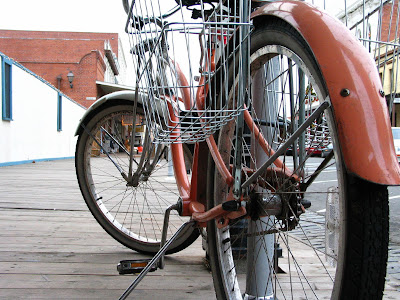
From Sierra Magazine, March/April 2008:
Two-Wheeled WonderI'm among those Sierra Club members who wonders why bicycles are so frequently overlooked by mainstream environmental organizations. After years of embracing "clean cars", bio-fuels, electric vehicles, hydrogen, fuel cells, CAFE standards, and other automotive pipe-dreams, could the eco-bigs be shifting to join the movement for trip reduction (livable cities, transit, density, walking, bicycling)?
The glory of lungs, legs, and steel
THE BICYCLE IS A MASTERPIECE of physics. It harnesses human muscle power directly to that old-time marvel--the wheel--and yields a vehicle more energy efficient than any other devised, ever, by anyone. A human on a bicycle is more efficient (in calories expended per pound and per mile) than a train, truck, airplane, boat, automobile, motorcycle, skateboard, canoe, or jet pack. Cycling is more efficient than walking, which takes three times as many calories per mile. Pound for pound, a person riding a bike can go farther on a calorie of food than a gazelle can running, a salmon swimming, or an eagle flying.
Oh, and the bicycle is hugely democratic: It is equally available to all. That's why on the highways, byways, and bikeways in most of the world, the bicycle is the most ubiquitous transport vehicle. Bicycles outnumber automobiles almost two to one worldwide, and their production outpaces cars by three to one. Rush-hour traffic in China is dominated by these human-powered vehicles. Even in the wealthy cities of Europe and Japan, a large share of the populace gets around by bike. Only here is it treated as little more than a plaything. About 50 million U.S. adults (and 40 million children) ride their bikes at least once each year, but only about 2 million are regular bike commuters. (Read more.)
The March/April issue of Sierra, published by the Sierra Club, dedicates its cover features to bicycling, including a fascinating historical article by Robert Gottlieb on the lost Pasadena-Los Angeles bike highway. Welcome to the velorution.
Image: Web capture.
Visit: Paul Dorn's Bike Commuting Tips Site
Thanks to Sierra Club's Megan Geuss for sending this.










